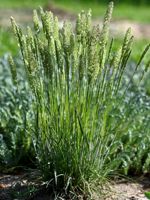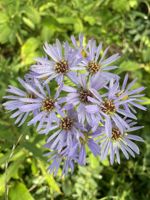Mon-Fri 9am - 5pm Mountain time
Junegrass vs Showy Aster
Koeleria macrantha
Eurybia conspicua
NOT AVAILABLE THIS SEASON - MIGHT RETURN
CUSTOM GROW
Junegrass is a native, low-growing perennial bunchgrass commonly found in prairies and open woodlands. It is a great choice for prairie restoration and naturalization projects or an attractive accent in ornamental plantings. Spear-shaped seed heads rise above the gray-green lower leaves, maturing to a tan color. Flowering earlier than other upright prairie grasses, it greens up quickly in spring and maintains its appeal well into the fall. It is shorter in stature and rarely forms thick stands, which adds to its understated visual appeal.
Adapted to cooler climates, Junegrass thrives in well-drained, rocky, sandy, or gritty soils and can tolerate drought, cold, and high altitudes. It actively grows in spring and fall when soil temperatures are cool, but in areas that are too hot or humid, it may go dormant by late summer.
As a perennial, it dies back to the crown each winter, it will regrow from the base in the spring. Avoid disturbing the crown during late winter to ensure healthy growth the following season.
Showy Aster is a native perennial wildflower recognized for its tall stems topped with clusters of light purple blooms. Blooming from late summer into autumn, it provides an important late-season source of nectar and pollen for pollinators. It also produces seeds that are eaten by birds, extending its value to wildlife beyond the flowering season.
Drought tolerant once established, Showy Aster grows well in urban, rural, and disturbed sites. With its mix of ecological value and ornamental appeal, it is ideal for pollinator gardens, naturalization projects, and ecological restoration.

